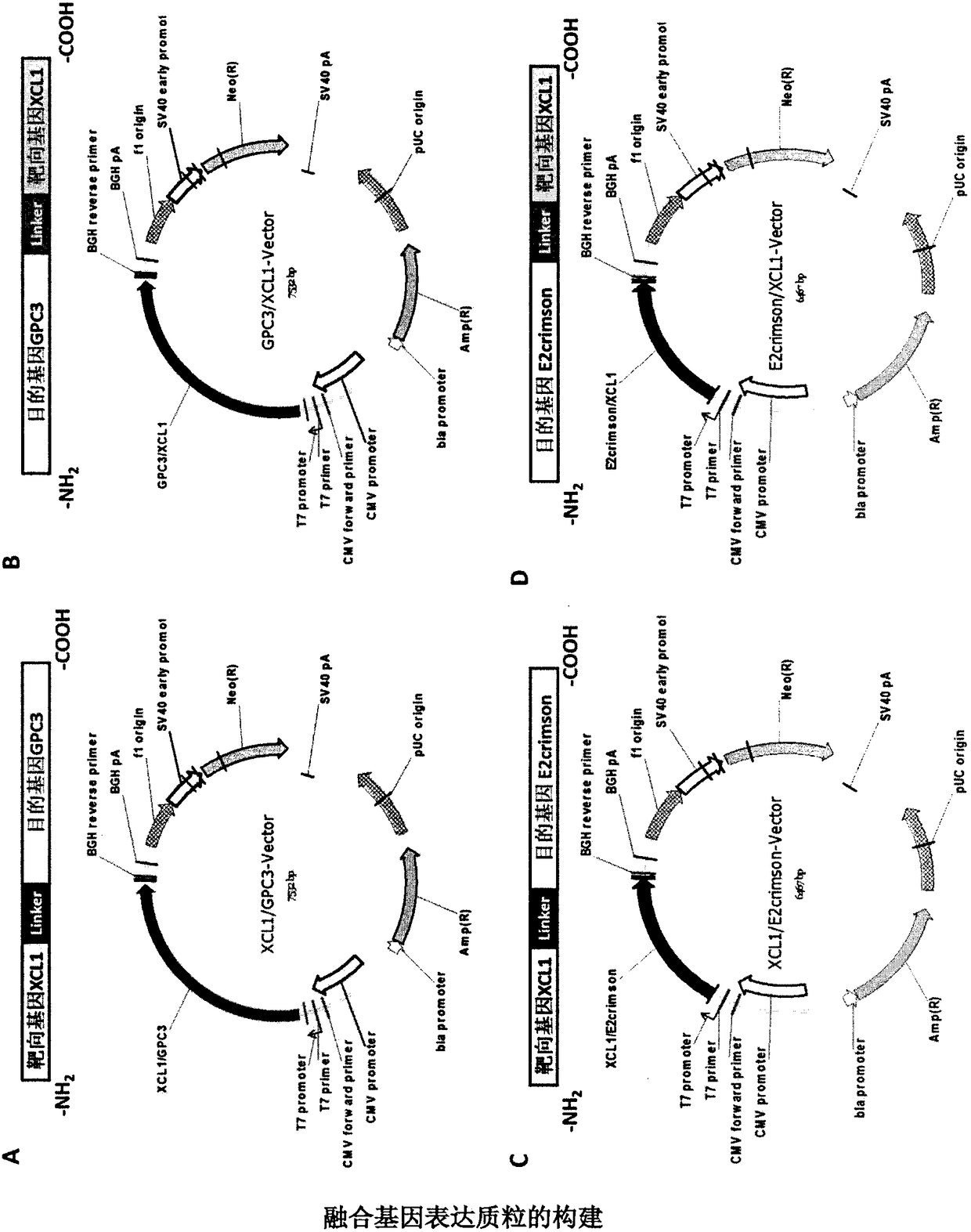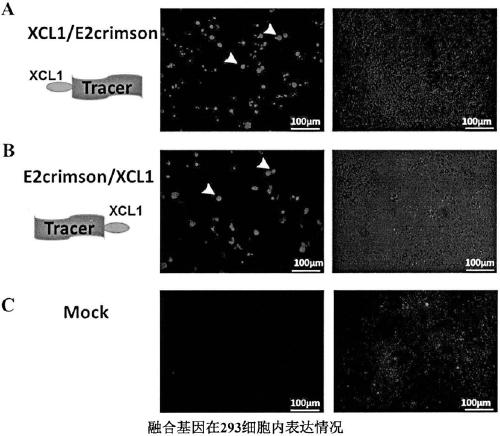Hepatocellular carcinoma vaccine targeting secondary lymphoid tissues
An amino acid and nucleotide sequence technology, applied in the direction of cytokines/lymphokines/interferons, drug combinations, cancer antigen components, etc., to achieve the effect of eliminating tumor cells and overcoming HLA restrictions
- Summary
- Abstract
- Description
- Claims
- Application Information
AI Technical Summary
Problems solved by technology
Method used
Image
Examples
Embodiment 1
[0126] Embodiment 1: fusion gene and fusion protein
[0127] 1. Construction of Fusion Gene Expression Plasmids
[0128] According to the amino acid sequences of human GPC3 protein (SEQ ID NO: 1) and mouse XCL1 protein (SEQ ID NO: 3), a GPC3-XCL1 fusion protein was constructed. At the same time, in order to ensure the mutual independence of the chemokine and the target protein in terms of spatial structure and exert normal chemotactic function, we designed a linker between GPC3 and XCL1, the corresponding amino acid sequence is: GGGGGSGGGGG (SEQ ID NO: 4 ), the nucleic acid sequence is: GGC GGA GGC GGA GGA TCA GGG GGA GGG GGAGGA (SEQ ID NO: 5). To facilitate the expression and secretion of fusion proteins in mammalian cells and to be targeted to XCR1 in lymph nodes + CD8α + In DC cells, we first replaced the signal peptide located at the amino terminal protein of the fusion protein with the mammalian signal peptide MGWSCIILFLVATATGVHS (SEQ ID NO: 6), and removed the signal ...
Embodiment 2
[0161] Example 2: Expression and localization of fusion genes in mice
[0162] 1. Plasmid immunization and material collection:
[0163] In vitro experiments, we found that whether the chemokine XCL1 is located at the amino-terminal or carboxyl-terminal of the fusion protein, it can be normally expressed in cells and secreted to the outside of the cell. Chemotactic XCR1 + CD8α + DC cells, therefore, in a further experiment, we selected a fusion gene expression plasmid with XCL1 located at the amino terminal of the fusion protein to immunize mice. According to the previous work in the laboratory, 24 hours before the mouse (C57BL / 6, 6 weeks old), inject 5 mg / ml bupivacaine hydrochloride into the quadriceps muscle of the mouse, 50 μl / mouse, to make the muscle mild Degree of injury, promote muscle cell regeneration to increase the amount of plasmid DNA absorbed by cells. Immunization was carried out on the second day. During the immunization, the mice were first anesthetized wi...
Embodiment 3
[0170] Example 3: The effect of fusion gene on the occurrence of primary liver cancer and its effect on the function of normal liver cells
[0171] 1. Construction of HBV / DEN mouse primary liver cancer model
[0172] In order to further test the intervention effect of the fusion gene expression plasmid on the primary liver cancer in mice, we constructed the HBV transgenic mouse primary liver cancer induced by the chemical carcinogen DEN (diethylnitrosamine, referred to as DEN) Liver cancer model ( Figure 7 A). HBV transgenic male mice (C57BL / 6J-TgN (AlblHBV) 44Bri, established by Chisari in 1985. Purchased from the Experimental Animal Center of Peking University Health Science Center) were injected with DEN solution (25 mg / kg body weight) intraperitoneally at 2 weeks after birth to induce HBV / DEN mouse liver cancer model (abbreviation: HBV / DEN mouse liver cancer model). Mice were sacrificed at the age of 22 weeks, and there were a large number of tumors in the liver and th...
PUM
 Login to View More
Login to View More Abstract
Description
Claims
Application Information
 Login to View More
Login to View More - R&D
- Intellectual Property
- Life Sciences
- Materials
- Tech Scout
- Unparalleled Data Quality
- Higher Quality Content
- 60% Fewer Hallucinations
Browse by: Latest US Patents, China's latest patents, Technical Efficacy Thesaurus, Application Domain, Technology Topic, Popular Technical Reports.
© 2025 PatSnap. All rights reserved.Legal|Privacy policy|Modern Slavery Act Transparency Statement|Sitemap|About US| Contact US: help@patsnap.com



